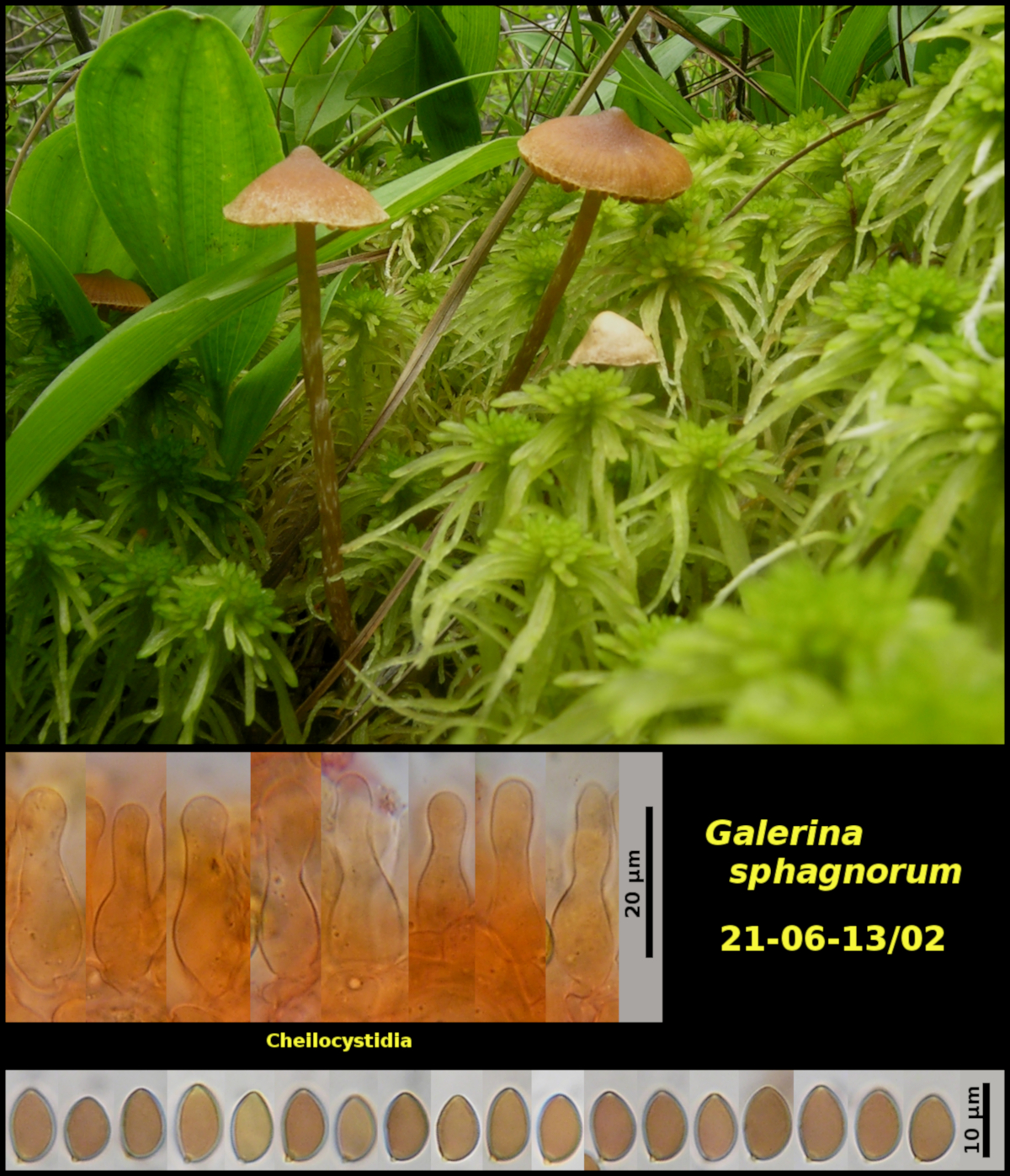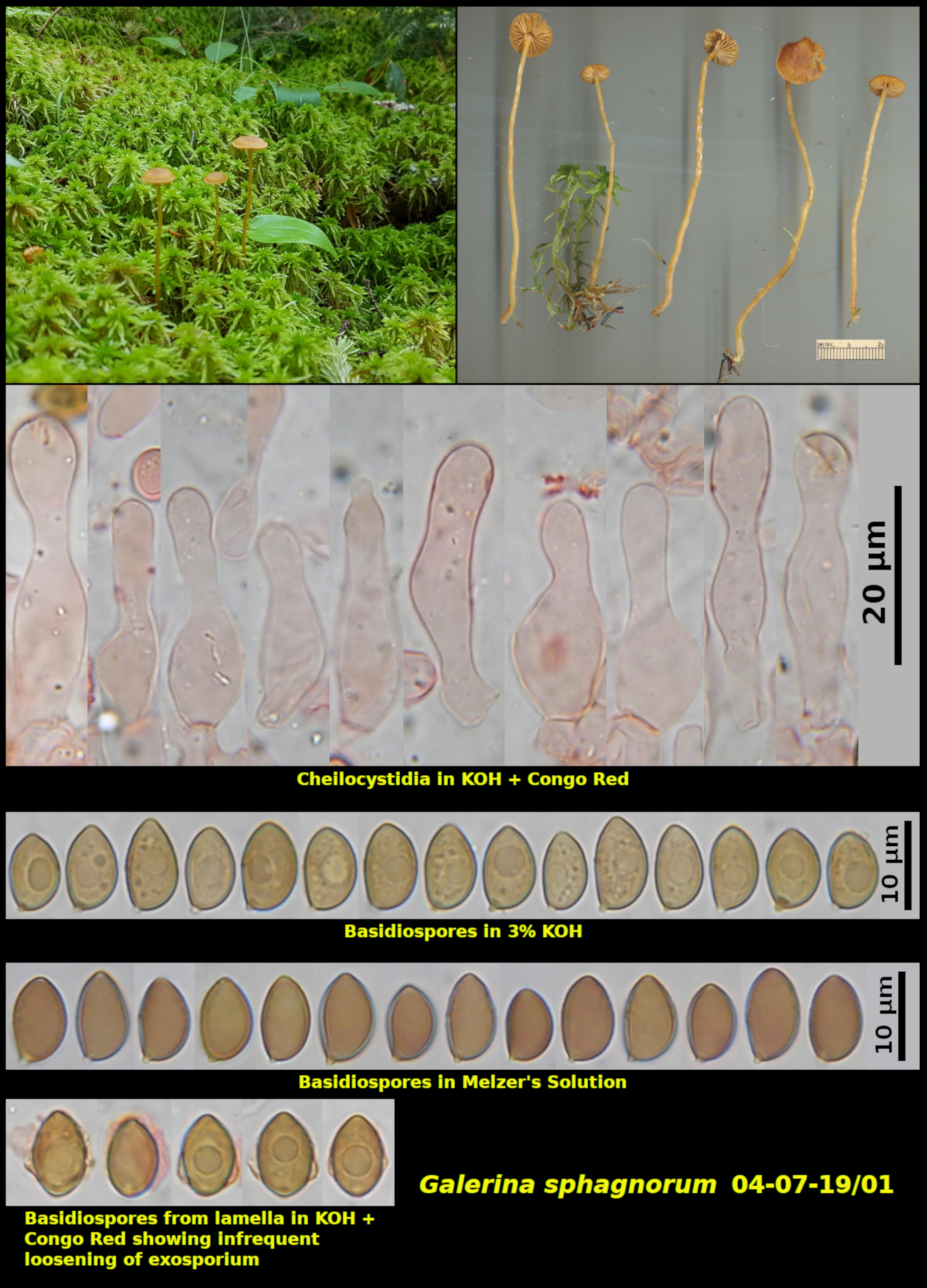Fleshy Fungi of New Brunswick >>
Galerina sphagnorum
Galerina sphagnorum (Pers.) Kühner


1. Scattered among gametophytes of Sphagnum sp. at the margin of a large bog with Picea mariana, Laric laricina and ericaceous shrubs, arising from the lower parts of the individual Sphagnum gametophytes, South of Bull Pasture Bog Protected Natural Area, New Brunswick (21-06-13/02).
2. Gregarious (5) on gametophytes of Sphagnum sp. in forest dominated by Picea rubens, Abies balsamea and Betula papyrifera. Kennedy Lakes Protected Natural Area, New Brunswick (04-07-19/01)
Basidiospores red brown in spore print, ovoid to ellipsoidal, with an acute apex and hyaline apical callus, finely roughened except on the smooth plage, only rarely with a loosening episporium in 3% KOH, 8.0-10.8 X 5.2-7.0 μm, Q = 1.44-1.76 (average: 9.2-9.6 X 5.8-6.1 μm, Q = 1.50-1.66). Cheilocystidia forming a continuous sterile margin, mostly lageniform to sublecythiform, 19-44 X 6.0-11.4 µm.
Galerina sphagnorum closely resembles G. sphagnicola, a species also found growing in Sphagnum carpets. The two species, as represented in New Brunswick, are difficult to distinguish even with a microscope. As classified by Smith and Singer they belong in two quite distinct sections of Galerina: Section Calyptrospora for G. sphagnicola and Section Mycenopsis for G. sphagnicola. Species in Section Calyptrospora are all characterized by having ascospores with a hyaline "exosporium" that separates from the rest of the spore, especially around the plage area, forming characteristic "ears". Members of section Mycenopsis were considered to lack this separable exosporium. Collection 04-07-19/01 has been puzzling because although the basidiospores from spore prints mounted in both Melzer's solution and in 3% KOH appear to lack a calyptra, some spores from lamellar surfaces mounted in KOH + Congo Red appear to have one. This presence of a calyptra is not very frequent, but is clearly recognizable when it occurs.
Finding occasional calytrate spores suggests that Collection 04-07-19/01 should belong in Section Calyptrospora while their rarity might rank this as a member of Section Mycenopsis with the calytrae being only freakish artifacts. The answer to this dilemma may be found in the 2005 paper by Gulden and Shachian-Tabrizi (Mycologia 97: 823-837) where a molecular phylogenic study of Galerina found that both G. sphagnicola and G. sphagnorum group fairly closely together in a lineage they informally named "mycenopsis". They point out that the traditional Section Calyptrospora is not well supported phylogenetically and that some species may have only occasionally calyptrate spores.
Distinguishing the New Brunswick collections in this group is still difficult but may be accomplished with this key:
1. Basidiospores regularly calyptrate in 3% KOH, with hyaline apical callus not conspicuous in Melzer's Solution, strongly and regularly dextrinoid. Cheilocystidia longer than 30 μm - G. sphagnicola
1. Basidiospores only infrequently appearing to be calyptrate in 3% KOH, with a prominent hyaline apical callus in Melzer's Solution, only irregularly and mostly lightly dextrinoid. Cheilocystidia often shorter than 30 μm - G. sphagnorum
A final word of caution: the "true" identity of these two species in New Brunswick and elsewhere is not fully established. Galerina sphagnorum is a European species, assumed but not proven to occur in North America. On the other hand, G. sphagnicola is a North American species not yet proven to occur in Europe but assumed to be there. For example, the excellent paper of Gulden and Shachian-Tabrizi used material of G. sphagnicola collected in northern Europe to represent that name, so we don't know for certain they were studying the same species we call by that name here. In Europe, G. sphagnorum is said to have a farinaceous odour and taste, while ours seem to lack that. Clearly, further work on this group is needed.
By the way, there is no easy remedy for the similarity of the two names. This may cause confusion, but we are stuck with it.
Photograph: D. Malloch (13-06-13/02, 04-07-19/01).